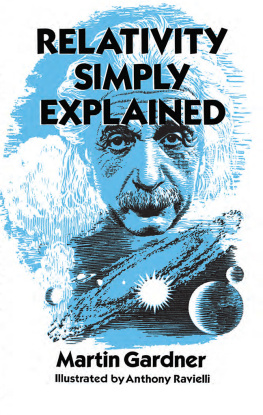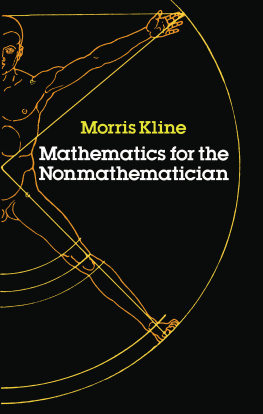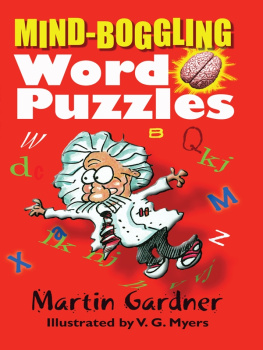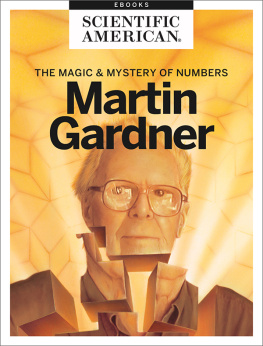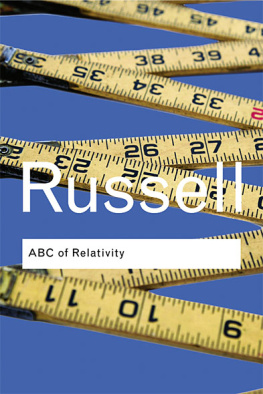Martin Gardner - Relativity Simply Explained
Here you can read online Martin Gardner - Relativity Simply Explained full text of the book (entire story) in english for free. Download pdf and epub, get meaning, cover and reviews about this ebook. year: 2012, publisher: Dover Publications, genre: Children. Description of the work, (preface) as well as reviews are available. Best literature library LitArk.com created for fans of good reading and offers a wide selection of genres:
Romance novel
Science fiction
Adventure
Detective
Science
History
Home and family
Prose
Art
Politics
Computer
Non-fiction
Religion
Business
Children
Humor
Choose a favorite category and find really read worthwhile books. Enjoy immersion in the world of imagination, feel the emotions of the characters or learn something new for yourself, make an fascinating discovery.
- Book:Relativity Simply Explained
- Author:
- Publisher:Dover Publications
- Genre:
- Year:2012
- Rating:5 / 5
- Favourites:Add to favourites
- Your mark:
- 100
- 1
- 2
- 3
- 4
- 5
Relativity Simply Explained: summary, description and annotation
We offer to read an annotation, description, summary or preface (depends on what the author of the book "Relativity Simply Explained" wrote himself). If you haven't found the necessary information about the book — write in the comments, we will try to find it.
Relativity Simply Explained — read online for free the complete book (whole text) full work
Below is the text of the book, divided by pages. System saving the place of the last page read, allows you to conveniently read the book "Relativity Simply Explained" online for free, without having to search again every time where you left off. Put a bookmark, and you can go to the page where you finished reading at any time.
Font size:
Interval:
Bookmark:
RELATIVITY SIMPLY EXPLAINED
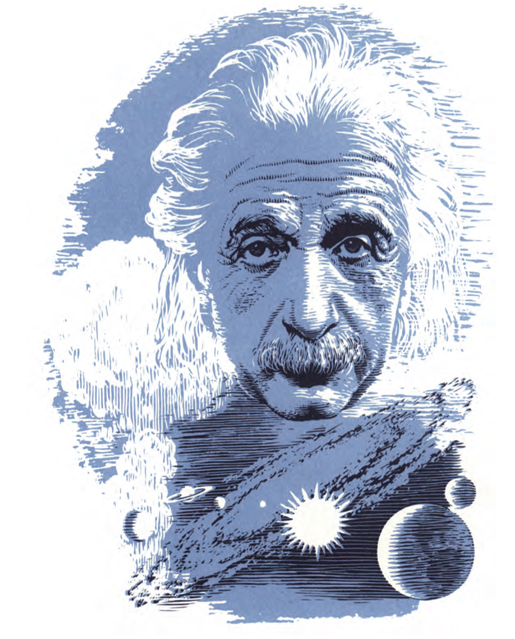
MARTIN GARDNER
Illustrated by
Anthony Ravielli
DOVER PUBLICATIONS, INC.
Mineola, New York
For Billie, a relative
Copyright
Copyright 1962, 1976, 1997 by Martin Gardner.
Illustrations copyright 1962, 1976 by Anthony Ravielli.
All rights reserved.
Bibliographical Note
This Dover edition, first published in 1997, is a corrected and enlarged republication of the work originally published in 1962 by the Macmillan Company, New York, under the title Relativity for the Million and revised in 1976 by Vintage Books (Random House), New York, under the title The Relativity Explosion. The Dover edition makes new corrections, restores all the 1962 illustrations in their original color, and adds a new Introduction and a new Postscript by the author.
Library of Congress Cataloging-in-fltblication Data
Gardner, Martin, 1914-[Relativity explosion]
Relativity simply explained / Martin Gardner,
p. cm.
Originally published: The relativity explosion. Rev. updated ed. New York : Vintage Books, 1976.
Includes index.
eISBN-13: 978-0-486-31561-4
1. Relativity (Physics) I. Title.
OC173.57.G37 1996
530.14 dc20
96-28034
CIP
The illustration by Anthony Ravielli on page 147 in Chapter 11 is based on Figure 33.2, page 908 from Gravitation by Charles W. Misner, Kip S. Thome and John Archibald Wheeler. W. H. Freeman and Company. Copyright 1973.
Manufactured in the United States by Courier Corporation
29315709
www.doverpubltcations.com
Contents
Introduction to the Dover Edition
Although here and there in this book there are minor corrections and additions, the main addition is a postscript. I have tried in that final chapter to update the book with brief discussions of major events in relativity theory and its confirmations during the twenty years that have passed since the revised second edition was published.
I never cared for the books two earlier tides: Relativity for the Million (1962), an echo of Lancelot Hogbens popular Mathematics for the Million, or The Relativity Explosion (1976). Hayward Cirker, president of Dover Publications, suggested the present tide. I much prefer it because it conveys exactly what the book is intended to be.
The second edition omitted many of Tony Raviellis illustrations, and dropped the blue color overlays from the pictures that were used. I am happy to report that his original art, with its color, is here restored.
Introduction to the 1976 Edition
This is a much revised, updated version of my book Relativity for the Million, published in 1962. Two entirely new chapters have been added: Chapter 7 to review the latest tests of Einsteins theory of gravity, Chapter 11 to report on three stupendous new astronomical discoveriesquasars, pulsars, and possible black holesthat are intimately connected with relativity. The last chapter has been gready expanded to provide an obituary for the steady-state theory of the cosmos, and to place more emphasis on the cur-rendy fashionable pulsating models. John Archibald Wheelers vision of a universe emerging from superspace, expanding, contracting, and re-entering superspace is shown to be a sophisticated elaboration of a model proposed by Edgar Allan Poe. Throughout the book there have been extensive revisions.
So many popular books on relativity had been written before 1962 that readers may wonder why I then wanted to write another one. I had three reasons:
1. The best introductions to elementary relativity had been written many years before 1962, and all of them were out of date. So many exciting new developments had taken place, all bearing on relativity theory, that I was convinced it was time for a new introductory book that would include this new material.
2. It was a challenge to try to explain once more, in a simple and entertaining way, the main aspects of Einsteins revolutionary theory. What did Einstein mean when he wrote Newton, forgive me? In my opinion anyone today who does not understand what he meant is as deficient in his education as someone who, a hundred years ago, knew nothing about Isaac Newtons great contributions to science. I myself was eager to learn more about relativity. Is there any better way to teach oneself a topic than to write a book about it?
3. No popular book on relativity had been illustrated so elaborately. Anthony Raviellis brilliant graphic art alone sets this book apart from earlier introductions.
If the reader wonders why the book contains no chapter on the philosophical consequences of relativity, it is because I am firmly persuaded that in the ordinary sense of the word philosophical, relativity has no consequences. For the theory of knowledge and the philosophy of science it obviously has implications, chiefly through its demonstration that the mathematical structure of space and time cannot be determined without observation and experiment. But as far as the great traditional topics of philosophy are concernedGod, immortality, free will, good and evil, and so onrelativity has absolutely nothing to say. The notion that relativity physics supports the avoidance of value judgments in anthropology, for example, or a relativism with respect to morals, is absurd. Actually, relativity introduces a whole series of new absolutes.
It is sometimes argued that relativity theory makes it more difficult to think that outside our feeble minds there is a huge world possessing an orderly structure that can be described in part by scientific laws. As the subject [relativity] developed, writes the English astronomer James Jeans in his book The Growth of Physical Science, it became clear that the phenomena of nature were determined by us and our experience rather than by a mechanical universe outside us and independent of us.
Jeanss idealism is a respectable metaphysical attitude, and there are even aspects of quantum mechanics that may bear upon it, but it receives not the slightest support from relativity. I will not argue the point here. It has been forcibly made by almost every modern philosopher of science. The interested reader will find a particularly clear discussion in Chapter 7, Metaphysical Interpretations of Relativistic Physics, in Philipp Franks Philosophy of Science.
Is there not something enormously narcissistic about the notion that we humans, with our crude little brains so recently evolved from the brains of beasts, are somehow partial creators of the universe? That nothing could be more distant from Einsteins own humility you will see at once when you read the beautiful quotation that follows as this books epigraph.
M.G.
Out yonder there was this huge world, which exists independently of us human beings and which stands before us like a great, eternal riddle, at least partially accessible to our inspection and thinking. The contemplation of this world beckoned like a liberation .
Albert Einstein,
Autobiographical Notes
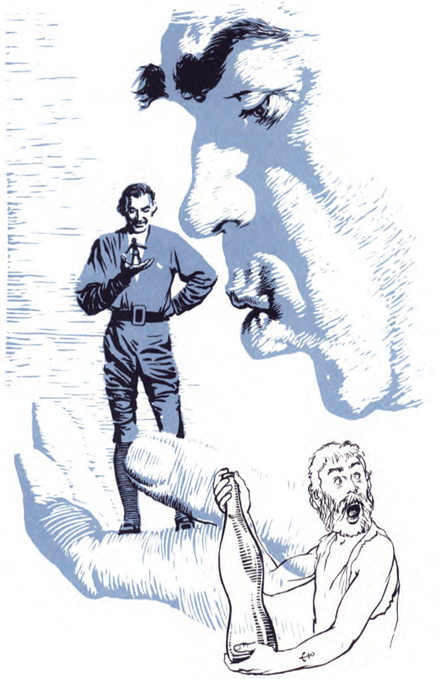
Two sailors, Joe and Moe, were cast away on a deserted island. Several years went by. One day Joe found a bottle that had washed ashore. It was one of those new king-size bottles of Coca-Cola. Joe turned pale.
Hey, Moe! he shouted. Weve shrunk!
There is a serious lesson to be learned from this joke. The lesson is: There is no way of judging the size of an object except by comparing it with the size of something else. The Lilliputians thought Gulliver a giant. The Brobdingnagians thought Gulliver tiny. Is a billiard ball large or small? Well, it is extremely large
Font size:
Interval:
Bookmark:
Similar books «Relativity Simply Explained»
Look at similar books to Relativity Simply Explained. We have selected literature similar in name and meaning in the hope of providing readers with more options to find new, interesting, not yet read works.
Discussion, reviews of the book Relativity Simply Explained and just readers' own opinions. Leave your comments, write what you think about the work, its meaning or the main characters. Specify what exactly you liked and what you didn't like, and why you think so.

